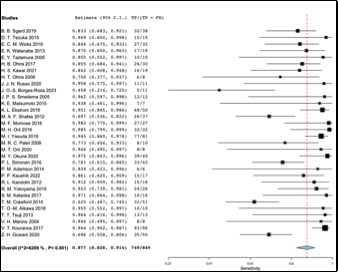Session Information
Session Type: Poster Session C
Session Time: 1:00PM-3:00PM
Background/Purpose: Autopsy reports for patients with sarcoidosis have suggested that up to 25% have cardiac involvement, mostly undiagnosed. Given the limited diagnostic accuracy of endomyocardial biopsy (EMB), newer modalities are necessary for the diagnosis of cardiac sarcoidosis (CS). Recently, several guidelines have been revised for the diagnosis of CS, as new technologies have been developed. However, the diagnosis of cardiac sarcoidosis remains challenging.
Methods: We systematically reviewed diagnostic test accuracy results in patients suspected of having CS of any age, presenting to inpatient or outpatient settings. The tests of interest for establishing diagnosis in our study are cardiac magnetic resonance imaging (CMR) and 18-fluorodeoxyglucose positron emission tomography (18F-FDG PET), EMB, and clinical diagnosis based on internationally accepted criteria.
We searched Cochrane Central, MEDLINE, and EMBASE for eligible studies, reference lists of relevant reviews, registered trials, and relevant conference proceedings. We included studies that reported data on diagnostic test accuracy (cohort studies, cross sectional studies) for CS. Two investigators screened and abstracted data. Risk of bias was assessed using QUADAS-2 and certainty of evidence using the GRADE framework. We pooled estimates of sensitivity and specificity.
Results: We systematically screened through 5960 records, of which 53 cohort studies were included for the final analysis (Figure 1). The pooled estimates for sensitivity and specificity for CMR reported in 33 studies were 88% (95% CI 83%-91%) and 69% (53%-81%), respectively (Figure 2). Regarding PET-CT, 37 studies reported on diagnostic accuracy, the pooled estimated for sensitivity were 80% (95% CI 75%-85%) and 73% (95% CI 65%-80%) for specificity (Figure 3). As for EMB, diagnostic accuracy was evaluated in 7 studies and had a pooled sensitivity of 29% (95% CI 13%-51%) (Figure 4). Certainty of evidence varied from low to moderate, seeing the high risk of bias in regards to the reference standard, which was in most cases based on the diagnostic criteria developed by international societies.
Conclusion: This systematic review and meta-analysis is the first study to provide accuracy estimates for different diagnostic modalities for the diagnosis of CS with pooled estimates collected from over 1000 patients in over 50 studies. The results show that the newer diagnostic imaging modalities have very promising diagnostic utility and could potentially be a safe substitute for the use of EMB to establish the diagnosis of CS. The results suggest that these modalities can be a starting point of any diagnostic criteria used for diagnosing CS accurately.
To cite this abstract in AMA style:
Abialmouna O, Kalot M, Hamade M, Bahuva R, Hasmi A, Ahmed A, Brumberger Z, Troy J, Choaib A, Bharucha R, Moyer R, Provost K, Page B, Sharma U. A Systematic Review and Meta-Analysis of Diagnostic Test Accuracy for the Diagnosis of Cardiac Sarcoidosis [abstract]. Arthritis Rheumatol. 2022; 74 (suppl 9). https://acrabstracts.org/abstract/a-systematic-review-and-meta-analysis-of-diagnostic-test-accuracy-for-the-diagnosis-of-cardiac-sarcoidosis/. Accessed .« Back to ACR Convergence 2022
ACR Meeting Abstracts - https://acrabstracts.org/abstract/a-systematic-review-and-meta-analysis-of-diagnostic-test-accuracy-for-the-diagnosis-of-cardiac-sarcoidosis/



